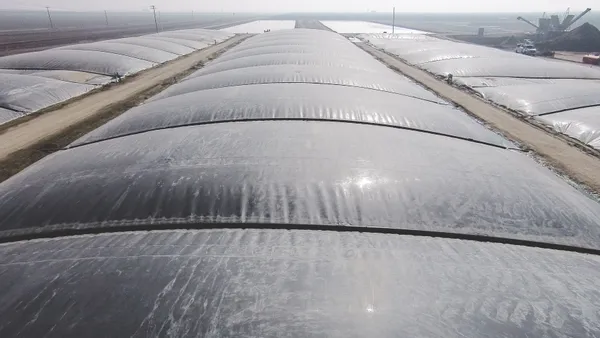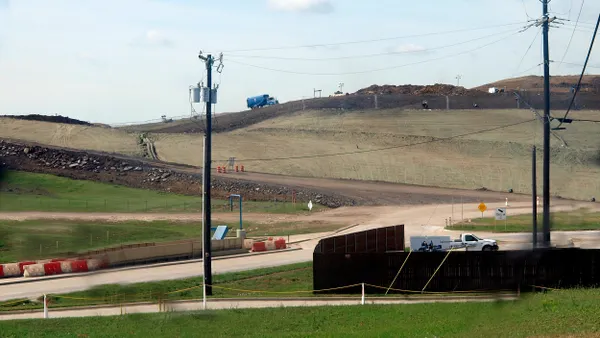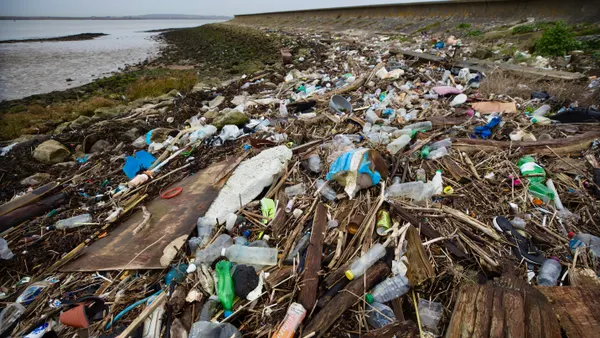Dive Brief:
- The U.S. EPA is soliciting comments on a series of white papers regarding landfill management practices through Jan. 23, 2025, the agency announced in a release. The agency said it is looking for ways to "streamline, improve, and harmonize the current suite of emissions regulations" for municipal solid waste landfills.
- The agency has previously indicated that it would update emissions regulations for new and existing landfills next year. It previously issued an update in 2016 but that was not fully adopted until 2021.
- In eight white papers, the agency included a series of possible changes to its New Source Performance Standards and Emissions Guidelines for new and existing landfills. Those changes include adding an organic waste diversion credit, allowing a regular aerial monitoring program, creating a methane emission threshold to trigger regulations for landfills and more.
Dive Insight:
The EPA has faced growing pressure to update its MSW landfill regulations, including from Congress. In January, the Senate Committee on Environment & Public Works held a hearing to address landfill emissions monitoring and mitigation efforts. There, Sen. Sheldon Whitehouse, D-R.I., said the EPA has handled emissions monitoring poorly for a long time, and committee leadership noted the need for updated rules.
In May, a group of nine senators also called on the EPA to send states more money to improve emissions monitoring efforts, noting the agency's own research finding it is likely undercounting methane emissions.
"Stronger EPA regulations for landfill emissions are critical to slash planet-warming methane emissions, advance environmental justice, and achieve our climate commitments," the senators wrote.
Agency staff indicated methane emissions would be a focus of EPA’s next rulemaking for landfill emissions, as scientists have begun to grapple with methane’s outsized greenhouse gas impact. In one of the newly released white papers, the agency proposed adding a threshold based on methane emissions which, once surpassed, would require landfills to install a gas collection and control system. Current regulations don’t require a landfill to install such a system based on methane emissions, relying instead on other gases and measurements.
The EPA's white papers also take note of rising emissions technologies, including aircraft and satellites. For its aerial monitoring white paper, the EPA tallied benefits and drawbacks for both remote sensing technologies and direct-air sampling, the latter of which is done by aircraft. It also discussed possible applications for the technology in federal New Source Performance Standard regulations, which govern newly commissioned landfills. Finally, it posed questions about how technologies could be incorporated, including reasonable levels of accuracy and when the technology should be deployed.
The agency's other white papers follow a similar format. In its gas collection system white paper, agency staff conducted a literature review of best practices for the systems. They looked at the impact of daily barometric pressure changes and liquid leachate levels, as well as technology to address those issues.
The agency also proposed making organic waste diversion from landfills a possible component of the next NSPS or EG regulation. Its white paper on that topic recognized this as a "departure from the current 'business-as-usual' approach" to landfill regulations.
In the paper, agency staff noted that the Environmental Integrity Project has previously posed organic waste diversion as an "alternative compliance mechanism" for landfills. The mechanism would work by crediting methane emissions reductions based on the amount of organic waste a landfill diverts from disposal. The EPA said it could also facilitate that diversion by creating a standing approval for projects like composting and anaerobic digestion undertaken by a landfill operator.
Other topics the white papers covered include daily, intermediate and final cover materials for landfills; gas control systems installation; and the size threshold past which landfills must be covered by regulations. The agency said it would release three additional white papers as part of the same docket “in the near future.” It plans to provide a separate opportunity for public comment on any future proposed rule regarding MSW landfills next year.











